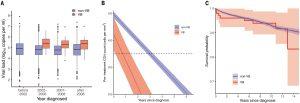Living in a global pandemic for the past few years has highlighted the importance of monitoring viral infections and their subsequent mutations, if any. We have lived through it and experienced how these viral infections impact the lives of humans. For example, the severe acute respiratory syndrome coronavirus-2 (SARS-CoV-2), has claimed more than 5.88 million lives and infected over 424 million individuals worldwide.
Through detection and identification of the SARS-CoV-2 Delta variant, we have seen it is more infectious and virulent than other variants. Additionally, the Delta variant is more likely to cause severe disease which has increased the mortality rate and hospitalization compared to the original SARS-CoV-2 strain and its other variants.
Due to a virus being susceptible to error-prone replication, mutations may occur, generating variants that may become of concern due to their altered transmissibility and virulence. Human Immunodeficiency Virus (HIV), an RNA virus, is one that is constantly altered due to its error-prone replication, claiming the lives of more than 33 million people globally.
First discovered in 1920 in Kinshasa, Democratic Republic of the Congo, HIV-1 since then has mutated into several variants. Studies of the past have described the difference in virulence between circulating recombinant forms (CRFs) and variants through investigation of the genotypic effects on virulence. These studies have also focused on host-pathogen interactions and epidemiology.
Treatment of HIV involves the prescription of Clinicians prescribe antiretroviral drugs (ARVs) to reduce the viral road and restrict the decline in CD4 count. If this treatment is unsuccessful, it would result in the acquisition of acquired immunodeficiency syndrome (AIDS).
In recent study published in Science, Wymant, et al., reported the presence of a subtype-B variant of HIV-1 with high virulence that has been spreading through the Netherlands during recent times (Figure 1). Part of the BEEHIVE project, they have identified a group of seventeen individuals with a specific subtype-B viral variant.

Figure 1: Clinical characteristics of VB individuals. Those infected with the highly virulent variant (VB individuals) are represented in red; those infected with any other subtype-B virus (non-VB individuals) are shown in blue. (A) Box-and-whisker plots of viral load, by year of diagnosis. Diagnosis dates were grouped to produce boundaries that coincide with years and roughly equal numbers of VB individuals (39 in 2002–2006, 35 in 2007–2008, and 27 after 2008; the pattern is robust to other groupings). (B) Expected decline in CD4 count in the absence of treatment. The model was adjusted for sex and age at diagnosis; values shown are for males diagnosed at the age of 30 to 39 years. Shaded regions indicate 95% CIs in the model’s prediction of mean values, given the uncertainty in estimation of parameter values (it does not reflect the variability between individuals in each of the two groups, which is much greater). The dashed black line denotes a CD4 count of 350 cells/mm3 (see text for details). (C) Probability of still being alive at a given time after diagnosis (Wymant, et al., 2022).
In this study, the researchers reported that the VB variant has been spreading in the Netherlands since the late 1990s. They highlighted the enhanced virulence and transmissibility of this variant.
For future they are hoping to conduct in vitro studies in order to determine the role of the viral genotype and to elucidate the mechanism of virulence mechanism at a molecular or cellular level. They also postulate that the variant has an increase replication ability when compared to other variants.
In their own words:
“Our discovery of a highly virulent and transmissible viral variant therefore emphasizes the importance of access to frequent testing for at-risk individuals and of adherence to recommendations for immediate treatment initiation for every person living with HIV”
Journal article: Wymant, C. et al., 2022. A highly virulent variant of HIV-1 circulating in the Netherlands. Science.
Summary by Stefan Botha










